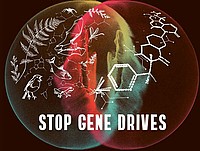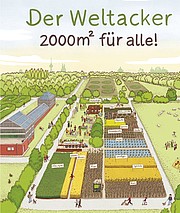Regulation of Gene Drive Organisms in Germany
In Germany, the political discussion and regulation of gene drives is still in it´s infancy. An official position of the German government on the evaluation and regulation of gene drive organisms is not yet available.
Genetic engineering safety regulation: safety standards for gene drive research
In the summer of 2019, Gene Drive Organisms were included and regulated for the first time in federal genetic engineering legislation. The Genetic Engineering Safety Ordinance (GenTSV) sets safety standards for handling GMOs in research laboratories.
In this context, work with genetically modified organisms is assigned to one of four safety levels depending on its hazard potential for humans, animals and the environment. Safety level 1 applies to work with no hazard potential, while safety level 4 applies to work with a high hazard potential. Depending on the safety level, different strict safety measures must be observed during experiments.
According to the Genetic Engineering Act (GenTG), the approval of a research project with GMOs, its classification into a safety level and monitoring of the safety requirements is the responsibility of regional authorities. According to §10 paragraph 7 GenTG, these authorities are obliged to obtain an opinion from the Central Commission for Biological Safety (ZKBS) in this process.
In 2016, in the absence of a uniform regulation by the Genetic Engineering Safety Ordinance, the ZKBS had defined safety level 2 as sufficient for the work with gene drive systems in the laboratory.¹ This was changed when the new version of the GenTSV came into force on 01.03.2021.
In the revised Genetic Engineering Safety Ordinance, genetic engineering in GDO is assigned to safety level 3 as a precautionary measure.² This ensures that every research project involving gene drives is reported to a supervisory authority and that a case-by-case risk assessment is carried out by the ZKBS before work begins. Another new regulation introduced by the GenTSV, by amending Article 1, §11, Paragraph 6, stipulates that the ZKBS must also prescribe specific safety requirements for work with GDOs as part of its recommendations to the regional authority, in order to reliably prevent the escape and propagation of GDOs into natural populations. Specific requirements for gene drive systems cannot yet be derived from the existing legal criteria, even in the new version of the GenTSV. As part of the approval procedure, the authority can assign the work to a different safety level on the basis of the risk assessment and the specific safety standards.³
These amendments were adopted by the Bundesrat (a federal constitutional organ which represents the German federal states in federal decision-making) against the proposal of the German federal government, which originally envisaged a basic classification of gene drives into safety level 2. With an open letter environmental and agricultural organizations had drawn the attention of the federal states to the fact that such a classification would not do justice to the potential threat posed by gene drive organisms to biodiversity.⁴
Positioning of the German Bundesrat
In its resolution on the amendment of the Genetic Engineering Safety Ordinance of June 2019, the Bundesrat acknowledges in a resolution that the release of gene drive organisms carries the risk of "irreversibly altering or wiping out entire populations of plants or animals."⁵ Furthermore, it refers to the declaration of the Network of GMO-Free Regions of Sept. 7, 2018, which expresses "the greatest reservations about the release of organisms that have so-called 'gene drives' that aim to alter the genetic characteristics of entire populations of plants and animals" and calls for "taking all necessary measures to prevent the release of gene drives into our environment."⁶ In this context, the Bundesrat calls on the German government to go beyond the Genetic Engineering Safety Ordinance by, "taking into account the precautionary principle, to give particular weight to the protected interests of Section 1 number 1 of the Genetic Engineering Act and, in particular, to nature conservation in the future design of the specifications for the risk assessment and safety classification of gene drive organisms."⁷
Positioning of the German federal states
At its 9th conference in September 2018, the European network of then 64 GMO-free regions in Europe, including 11 German states, adopted a Berlin Declaration calling on national governments and the European Union to stop the release of gene drives in the European Union and to advocate at the international level, in the context of the UN Convention on Biological Diversity (CBD) and the IUCN, for a moratorium on the release of gene drive organisms.⁸
At the Conference of Agriculture Ministers (AMK) in September 2019, the agriculture ministers of the German federal states called on the German government to put gene drive organisms back on the agenda of the Conference of the Parties to the UN Convention on Biological Diversity (CBD) and its Biosafety Protocol at COP 15 in China on the occasion of the six-month EU Council Presidency in the second half of 2020.⁹
Positioning of the Ministry of Environment
The Environment Ministry has been critical of the use of gene drive technology in nature. In response to an open letter from environmental and nature conservation organizations in the run-up to COP 14, a senior ministry official said in September 2018 that the ministry would work to prevent the release of gene drive organisms in Germany or Europe as long as negative effects on the environment could not be ruled out. Furthermore, the ministry would advocate for the preservation of the precautionary principle in international negotiations within the framework of the CBD. She sees a great need for research and adaptation with regard to the environmental risk assessment of gene drive organisms.¹⁰
Process in the German Bundestag
The German Bundestag (the German parliament) has commissioned its Office of Technology Assessment (TAB) on a cross-party basis to answer open ecological, ethical and regulatory questions surrounding the risks and options for action as well as alternatives to gene drive technology in a technology assessment by the end of 2021. The report is intended to help the German Bundestag find a position on the subject.¹¹
Positioning of the German parties
At the request of an alliance of environmental and agricultural associations in spring 2019, the Social Democratic Party of Germany (SPD)¹², Bündnis90/DieGrünen (the Green Party)¹³ and Die Linke (Left party)¹⁴ declared their support for an international gene drive moratorium. The Christian Democratic Union of Germany (CDU) described this idea as worthy of consideration.¹⁵ The Liberal Democatatic Party (FPD) and Alternative for Germany (AfD) did not take a position on this.
Research Project on Risk Assessment & Monitoring of Gene Drives on behalf of the German Federal Agency for Nature Conservation (BfN)
Risk assessment and monitoring plans for the release of genetically modified organisms into the wild, which include gene drive organisms, are based on European Union laws, principles, procedures and requirements. However, the implementation of the approval and the execution of the monitoring is up to the EU member states.
For this reason, the Federal Agency for Nature Conservation (BfN), which is responsible for the environmental risk assessment of GMOs in Germany, initiated a research project at the end of 2018 to identify potential risks and fundamental challenges for the risk assessment of gene drive organisms before the first field experiments with GDO take place. Theresearch project conducted at the University of Natural Resources and Applied Life Sciences, Vienna, aims to identify, among other things, the new challenges that gene drive technology poses to risk assessment and how the ecological consequences of gene drives can be recorded and evaluated. To this end, the project will also examine the extent to which gene drives can be contained spatially and temporally and what role computer-based modeling can play in the assessment of environmental risks. In addition, the project will analyze how the EU-mandated monitoring of GMOs for gene drives would need to be adapted to capture and assess their environmental impact after a release.¹⁶ Results of the project are expected to be available in autumn 2021.
Sources:
[1] Central Commission for Biosafety website (2016). Central Biosafety Commission; c2019. ZKBS statement on the classification of genetic engineering work for the production and use of higher organisms with recombinant gene drive systems. Online: http://www.zkbs-online.de/ZKBS/SharedDocs/Downloads/01_Allgemeine%20Stellungnahmen/01_Allgemeine%20Themen/Bewertung_von_Gene-Drive_Systemen_2016.html;jsessionid=E2328C44965B2EFEF6859B095A4E88E0.2_cid350?nn=10944862#download=1 [last accessed: 10/22/2020].
[2] Ordinance on Safety Levels and Safety Measures for Genetic Engineering Work in Genetic Engineering Plants (Genetic Engineering Safety Ordinance - GenTSV) – Online: https://www.buzer.de/GenTSV.htm [last accessed:10-03-2021]
[3] Ibid.
[4] Janßen G, Weiger H, Potthof C, Gelinsky E, Härlin B, Then C (2019). Letter to: Behrendt D (Berlin). 2019 Apr 11. Genetic engineering safety regulation must reliably prevent the escape of highly invasive gene drive organisms! Online: https://www.saveourseeds.org/fileadmin/pics/SOS/genedrives/Verb%C3%A4ndebrief_an_L%C3%A4nder_GTSV_ohne_Signatur.pdf [last accessed: Oct 22, 2020].
[5] German Bundesrat (2019). Drucksache 137/19 (Beschluss) - Resolution of the Bundesrat - Ordinance on the reorganization of the law on safety levels and safety measures for genetic engineering work in genetic engineering facilities. p. 18. Online: https://www.bundesrat.de/SharedDocs/drucksachen/2019/0101-0200/137-19(B).pdf?__blob=publicationFile&v=1 [last accessed: 22.10.2020]
[6] European GMO-Free Regions Network (2018). Berlin Declaration 2018. 9th European Conference of GMO-Free Regions; 2018 Sep 7; Berlin, Germany. Online: https://umwelt.hessen.de/sites/default/files/media/hmuelv/deklaration_gentechnikfreier_regionen_.pdf [last accessed: 22 Oct 2020].
[7] German Bundesrat (2019). Drucksache 137/19 (Beschluss) - Resolution of the Bundesrat - Ordinance on the reorganization of the law on safety levels and safety measures for genetic engineering work in genetic engineering facilities. p. 18. Online: https://www.bundesrat.de/SharedDocs/drucksachen/2019/0101-0200/137-19(B).pdf?__blob=publicationFile&v=1 [last accessed: 22.10.2020]
[8] European GMO-Free Regions Network (2018). Berlin Declaration 2018. 9th European Conference of GMO-Free Regions; 2018 Sep 7; Online: https://umwelt.hessen.de/sites/default/files/media/hmuelv/deklaration_gentechnikfreier_regionen.pdf [last accessed: 22 Oct 2020].
[9] Conference of Agriculture Ministers (2019). Conference of Ministers of Agriculture, 27.09.2019 in Mainz. Final Record of Results, Item 12, Decision 4; Online: https://www.agrarministerkonferenz.de/documents/endgueltiges-ergebnisprotokoll-amk-mainz_1570787484.pdf [last accessed: 07.12.2020].
[10] Federal Ministry for the Environment, Nature Conservation and Nuclear Safety (2019). Letter to: Then C (Munich). 2018 Sep 24. Open letter, July 04, 2018. Online: https://www.testbiotech.org/sites/default/files/Antwort%20BMU_Gene%20Drive_2018%20%281%29.pdf [last accessed: Dec 07, 2020].
[11] Office of Technology Assessment at the German Bundestag (TAB) Website (2019). Information on the project. Gene drives - technologies for propagating genetic modifications throughout populations. Online: www.tab-beim-bundestag.de/de/untersuchungen/u50000.html [last accessed: 07.12.2020].
[12] Social Democratic Party of Germany (SPD), the Party Executive Committee (2019). Letter to: Arbeitsgemeinschaft bäuerliche Landwirtschaft (AbL) e.V. and other leading associations from agriculture, environment and society. 2019 Apr. 17. Online: https://www.saveourseeds.org/fileadmin/pics/SOS/genedrives/201904_Antwort_SPD_auf_Brief_EU-Spitzenkandidaten_bzgl_ngt_Gene_Drive_und_Patente.pdf [last accessed Dec. 07, 2020].
[13] Bündnis 90 / Die Grünen (2019). Letter to: Arbeitsgemeinschaft bäuerliche Landwirtschaft (AbL) e.V. Answers to the election test questions of the Arbeitsgemeinschaft bäuerliche Landwirtschaft (AbL) on the occasion of the European elections 2019. 2019 Apr. 3. Online: https://www.saveourseeds.org/fileadmin/pics/SOS/genedrives/201904_Antwort_Gr%C3%BCne_auf_Brief_EU-Spitzenkandidaten_bzgl_ngt_Gene_Drive_und_Patente.pdf [last accessed: 07 Dec. 2020].
[14] Die Linke, Bundesgeschäftsstelle (2019). Letter to: Arbeitsgemeinschaft bäuerliche Landwirtschaft AbL e.V. (Lüneburg). Wahlprüfsteine Election to the European Parliament 2019. 2019 Mar. 29. Online: https://www.saveourseeds.org/fileadmin/pics/SOS/genedrives/201904_Antwort_Die_Linke_auf_Brief_EU-Spitzenkandidaten_bzgl_ngt_Gene_Drive_und_Patente.pdf [last accessed: 07 Dec. 2020].
[15] Christian Democratic Union of Germany (CDU) and Christian Social Union in Bavaria (CSU) (2019). Letter to: Arbeitsgemeinschaft bäuerliche Landwirtschaft (AbL). Responses of the Christian Democratic Union of Germany (CDU) and the Christian Social Union in Bavaria (CSU) to the questions of the Arbeitsgemeinschaft bäuerliche Landwirtschaft (AbL) on the 2019 European Parliament elections. 2019 Apr 10. Online: https://www.saveourseeds.org/fileadmin/pics/SOS/genedrives/201904_Antwort_CDU_auf_Brief_EU-Spitzenkandidaten_bzgl_ngt_Gene_Drive_und_Patente.pdf [last accessed: Dec 07, 2020].
[16] University of Natural Resources and Life Sciences Vienna website (no year). University of Natural Resources and Life Sciences Vienna; c2004-2020. potential risks of synthetic gene drive systems and monitoring requirements. Online: https://forschung.boku.ac.at/fis/suchen.projekt_uebersicht?sprache_in=de&menue_id_in=300&id_in=12617 [last accessed: 07.12.2020]



